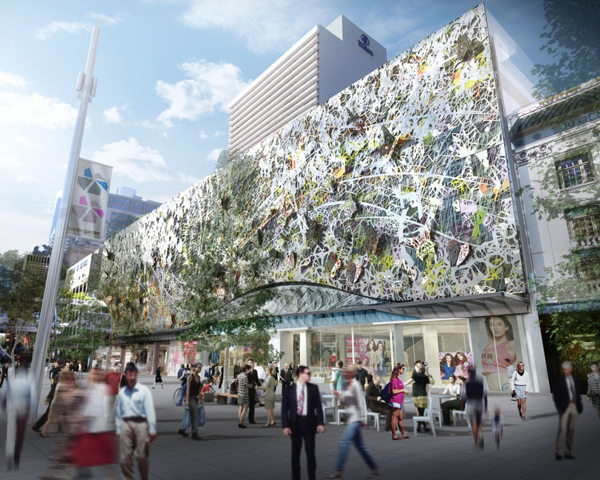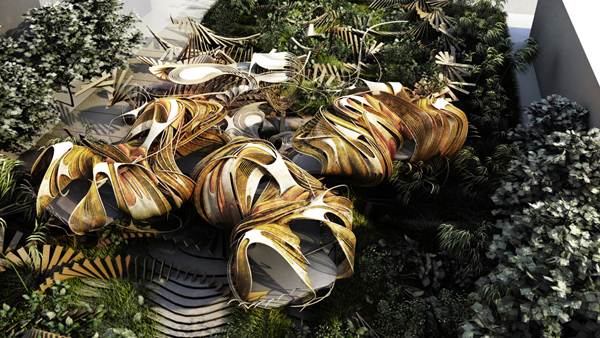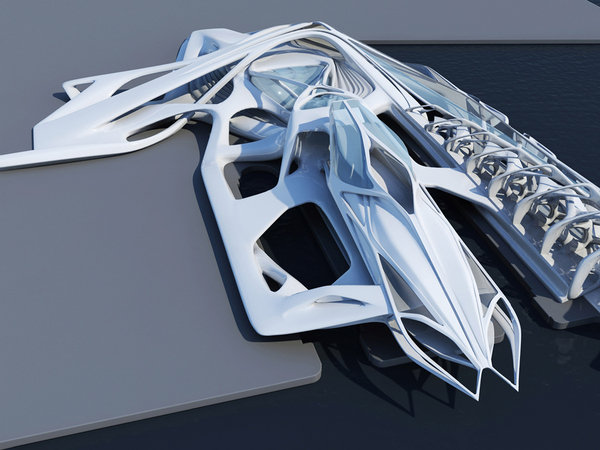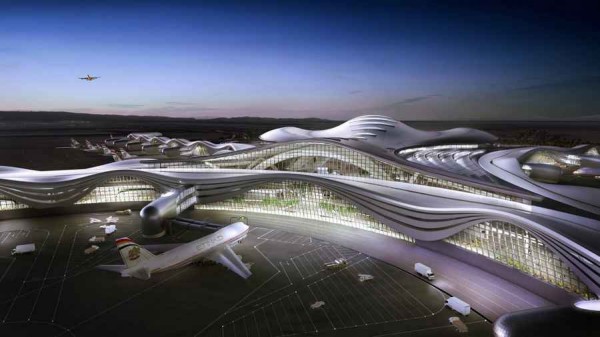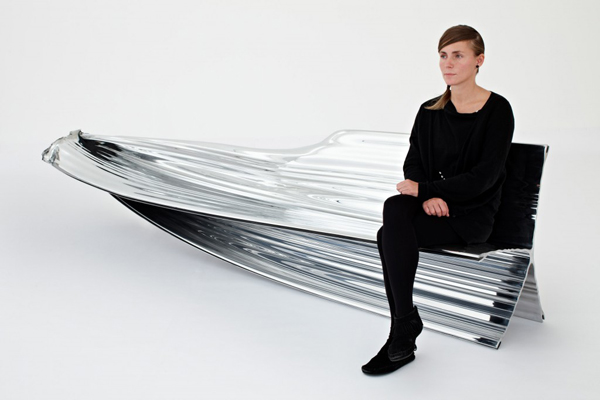The three frontages of the Wintergarden Shopping Center in Brisbane have acquired a new look. Designed by Studio 505, the project for the new facades was conceived as a combination of commercial entertainment and architecturally engaging detailing. The abstract geometry of the screens is achieved by overlapping layers of different patterns, resulting in a radically experiential composition that communicates the rich diversity of city life. Read the rest of this entry »
New Facade for the Wintergarden Shopping Center Overlaps Pattern Layers / Studio 505
River-Yard in Amsterdam/ Aie Architectes
The River-Yard Project by Aïe Architectes, part of a Concours AC-CA competition, functions as both a literal pedestrian bridge as well as a large, urban living space for the city of Amsterdam. River-Yard acts as a linear connection between opposing banks of the canal fronting the Hermitage Amsterdam Museum’s monumental entrance. This path is extended on either side to create a large, open space whose thick ground plane is then pushed and pulled in order to accommodate programmatic elements. This project places emphasis on the notion of balance, pushing and pulling of ground planes, as well as the interplay between solid, void, public, and commercial. Read the rest of this entry »
Biomolecular Self Assembly / Skylar Tibbits + Arthur Olson
Studies on self assembling structures continue, as Skylar Tibbits and Dr. Arthur Olson of MIT in collaboration with Autodesk Research present project Biomolecular Self Assembly at this year’s TEDGlobal 2012: Radical Openness.
While programmable self-assembly has been studied at the molecular level for some time now, this project promotes the idea of using energy to interactively reassemble molecular structures. Instead of using smart robotic systems to construct these structures (like Gramazio & Kohler did in their flight assembled tower), kinetic energy found in extreme near-zero gravity environments or places of high altitudes, space, or underwater, could cause polarized particles to self assemble. “Imagine using wave energy underwater to trigger the self-assembly of multistory structures, or parts dropped from high altitudes to unfold fully erected structures, or even modular, transformable and reconfigurable space structures!”
Three components–geometry, energy, and attraction–are needed for self assembly. Particles assemble as in a biological model of enzymes to specific geometries, creating the most stable geometrical structure after a process of weeding out bad bonds and re-assemblies. Read the rest of this entry »
Cross-Pollinated Software Tactics Bridge Architecture and Automotive Design
Bundle House – Generating and Controlling Three-Dimensional Form
The project was created as part of Hernan Diaz Alonso’s Spring 2012 XLAB studio at SCI-Arc, an exercise in form and generative artificial landscaping. Designed by students Keyla Hernandez and Jason Orbe-Smith, the Bundle House is a single family home located in Los Angeles, California. Reinterpreting the ground as a potential three-dimensional grid, the project develops through deformation and a series of disruption of this linear system. It stems from a flat site and transforms space into an organically shaped, semi-open living area. Enclosures and apertures are generated by the density of linework, offering both privacy and filtered views to the exterior landscape. Read the rest of this entry »
Mesh Infrastructure in Tree Canopies Allows for Scientific Exploration / Yi Yvonne Weng
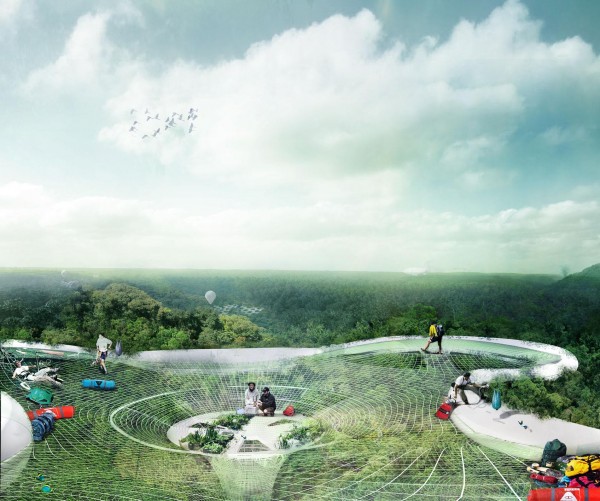
Fifth year diploma Architectural Association student Yi Yvonne Weng has recently won the 2012 Foster + Partners Prize for her project “The 6th Layer – Explorative Canopy Trail,” which addresses the theme of sustainability and infrastructure by seeing the Brazilian Amazon forest as a natural infrastructure to work with and not against.
Her design utilizes an ultra lightweight, self-sustaining and versatile architectural system located above three tree canopies. This new space above the trees triggers new ways to interact and perceive the forest. Intended for scientific research, ecotourism and harvesting of the Amazon’s unique medicinal plants, Weng’s system is an environmentally conscious solution to exploring the biological gems of the forest without harming it. Read the rest of this entry »
Tandanor Performing Arts Center / Monad Studio
The Tandanor Performing Arts Center is designed as a composition of sweeping forms and intricate spatial trajectories that stem from the existing urban network of Buenos Aires waterfront. The natural horizontality of the waterfront is contrasted against the historical skyline of the city, dominated by vertical buildings. In order to introduce new content to the public realm, the project alternates sequences of public foyers and halls with multiple access points to a large roof-plaza. Grafted onto the figure of an old shipyard, the Performing Arts Center seeks to operate directly from within the landscape conditions.
Programmatically, the building is designed in layers: the inner spaces hold a series of auditoria, public foyers, and great halls, while the outermost facilitates rehearsal rooms, workshops, a boardwalk with restaurants, and various retail and leisure attractions. Arriving from Antartida Argentina Avenue, an important artery along the waterfront, visitors are exposed to a transition from the uniformity of the coastal skyline to diversified horizontality of the Center. Through the introduction of multiple access points, they are allowed to choose their own spatial experience. Read the rest of this entry »
Construction Set for Abu Dhabi International Airport Midfield Complex / KPF
KPF‘s design for Abu Dhabi International Airport Midfield Complex has recently been signed for fall 2012 construction and is to be completed by 2017.
One of the fastest growing airports in a popular tourist destination, the ‘Garden of the Gulf’ serves as a monumental gateway to the city and is considered a key player in the 2030 master plan. Fundamentally adapting to the airports’ growing capacity and adaptability, the terminal processes almost 50 million travelers each year, and the expansion will help accommodate and increase passenger experience through larger interior zones. The x-shaped terminal complex provides efficient programmatic function, housing more than 18,000 sq m of facilities and retail, almost 10,000 sq m of international restaurants, over 27,500 sq m of hospitality and a cultural museum, and 49 gates. Read the rest of this entry »
Aluminium Extrusion Bench / Heatherwick Studio
Designed by Heatherwick Studio, these seating structures are made from a single piece of aluminium. Without any fixtures or fittings, the component is created through a specific aluminium-extrusion process, resulting in unexpected forms of raw and sculptural qualities.
The aluminium extrusion process is usually used to make smaller section components for façade systems, train carriages, automotive parts and so on. A large press capable of exerting up to ten thousand tons of pressure creates the extruded sections by squeezing aluminium through its die (the opening that forms the shape of the profile to be created). The aluminium emerges in a raw unpolished finish which is then cut and sometimes shaped; each cut piece of bench then undergoes 300 hours of polishing. If pieces of the extrusion are not used they are melted down and made into further billets. With technological advancements, this principle finally found its application in the design industry, making it possible for the eighteen years old idea for the Extrusion Project to be realized. Read the rest of this entry »
Screenplay Installation / Oyler Wu Collaborative
‘Screenplay’ is a 21-foot-long architectural installation designed and fabricated by the Los Angeles-based Oyler Wu Collaborative on view at the Los Angeles Convention Center as a featured installation of Dwell On Design 2012. This installation takes the form of a screen wall comprised of five modules, each more of five custom , intricately welded steel tube profiles. These twenty five profiles are in turn, strung with 45,000 linear feet of silver polypropylene rope, creating an oscillating and fluid sense of three dimensional movement from an aggregation of two dimensional lines. The intention of Screenplay, Oyler Wu collective states, is to inspire “a sense of curiosity by slowly revealing its form and complexity through [the viewer’s] physical and visual engagement with the work.’ Screenplay is approached from a frontal perspective, revealing a relatively flat, though rich, composition of metal and rope ‘lines.’ As the viewer’s perspective shifts to the oblique, Screenplay takes on more spatial qualities, inviting both further exploration and wonder. Screenplay also incorporates a nested bench, located just off its center, providing seating for the viewer, and encouraging physical interaction with what would normally be considered a purely visual object. Read the rest of this entry »

